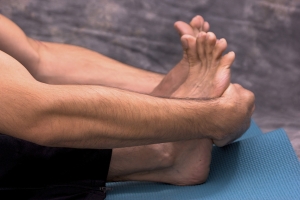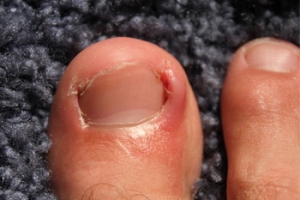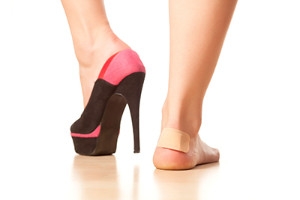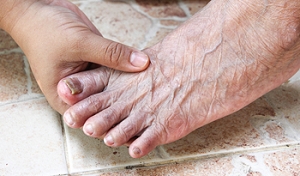Connect With Us
Blog

The Benefits of Performing Proper Foot Stretches
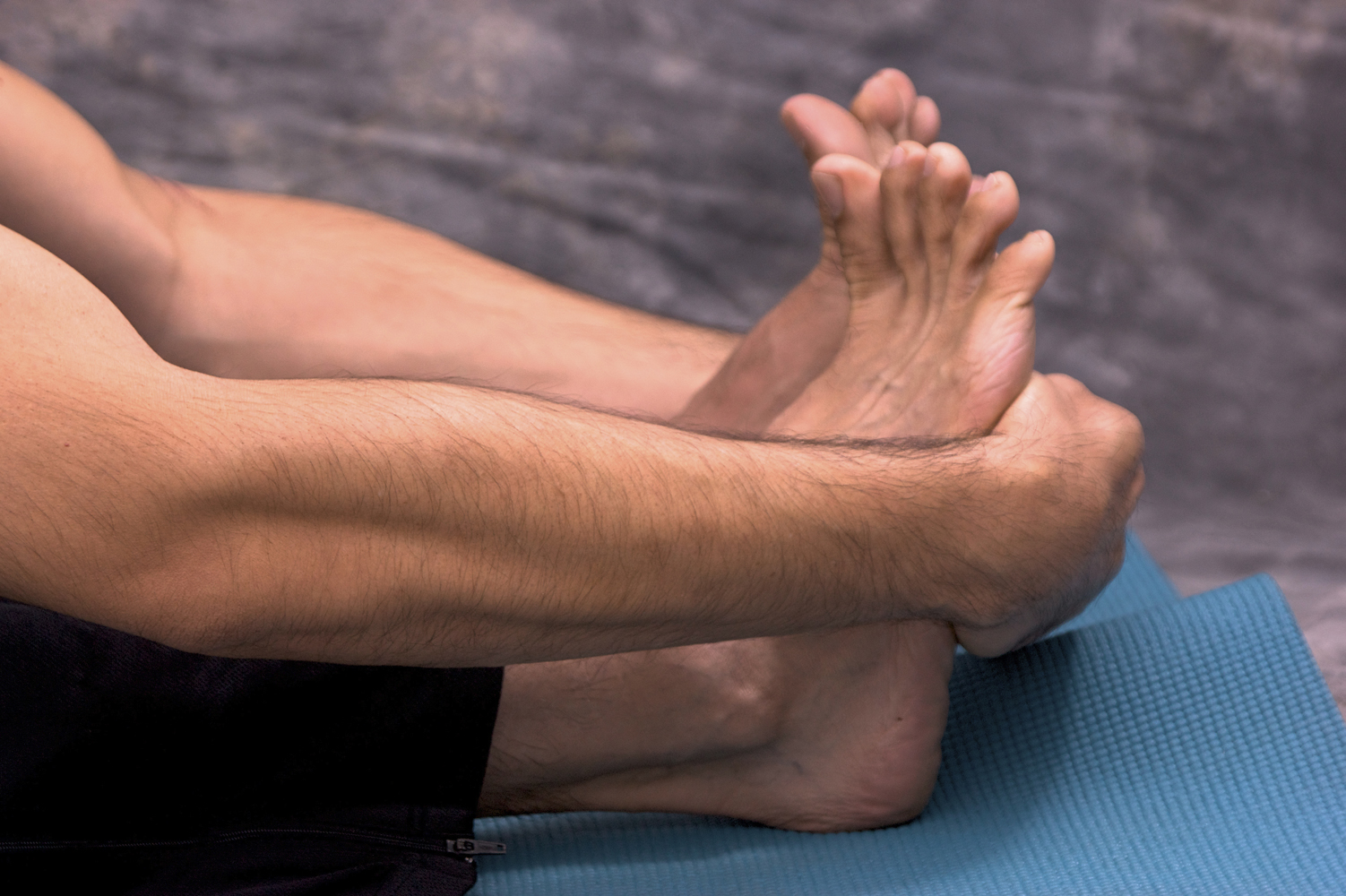 The feet are considered to be the foundation of the body and it’s important to maintain strength by stretching and exercising the toes and ankles frequently. There are numerous ligaments and tendons that connect the bones in the feet to the calves and performing stretching techniques will benefit the overall health of the legs. Stiff ankles and feet may develop when the muscles are not strong enough to support the feet in daily activities. When certain stretches are practiced, the feet may become stronger. These may include circling your foot and then switching directions in addition to pointing and flexing the toes. Tight ankles may be avoided by performing stretches that strengthen the calves. This can be achieved by standing on the edge of a step while dropping the heel until a comfortable stretch is felt. Additionally, massaging the calves will not only feel good but may benefit in circulating blood to the legs. If you would like additional information about how to perform foot stretches, please call a podiatrist.
The feet are considered to be the foundation of the body and it’s important to maintain strength by stretching and exercising the toes and ankles frequently. There are numerous ligaments and tendons that connect the bones in the feet to the calves and performing stretching techniques will benefit the overall health of the legs. Stiff ankles and feet may develop when the muscles are not strong enough to support the feet in daily activities. When certain stretches are practiced, the feet may become stronger. These may include circling your foot and then switching directions in addition to pointing and flexing the toes. Tight ankles may be avoided by performing stretches that strengthen the calves. This can be achieved by standing on the edge of a step while dropping the heel until a comfortable stretch is felt. Additionally, massaging the calves will not only feel good but may benefit in circulating blood to the legs. If you would like additional information about how to perform foot stretches, please call a podiatrist.
Stretching the feet is a great way to prevent injuries. If you have any concerns with your feet consult with one of our podiatrists from Family Foot Care of Long Island. Our doctors will assess your condition and provide you with quality foot and ankle treatment.
Stretching the Feet
Stretching the muscles in the foot is an important part in any physical activity. Feet that are tight can lead to less flexibility and make you more prone to injury. One of the most common forms of foot pain, plantar fasciitis, can be stretched out to help ease the pain. Stretching can not only ease pain from plantar fasciitis but also prevent it as well. However, it is important to see a podiatrist first if stretching is right for you. Podiatrists can also recommend other ways to stretch your feet. Once you know whether stretching is right for you, here are some excellent stretches you can do.
- Using a foam roller or any cylindrical object (a water bottle or soda can will do), roll the object under your foot back and forth. You should also exert pressure on the object. Be sure to do this to both feet for a minute. Do this exercise three times each.
- Similar to the previous one, take a ball, such as a tennis ball, and roll it under your foot while seated and exert pressure on it.
- Grab a resistance band or towel and take a seat. If you are using a towel, fold it length wise. Next put either one between the ball of your foot and heel and pull with both hands on each side towards you. Hold this for 15 seconds and then switch feet. Do this three times for each foot.
- Finally hold your big toe while crossing one leg over the other. Pull the toe towards you and hold for 15 seconds. Once again do this three times per foot.
It is best to go easy when first stretching your foot and work your way up. If your foot starts hurting, stop exercising and ice and rest the foot. It is advised to then see a podiatrist for help.
If you have any questions, please feel free to contact our office located in Port Jefferson Station, NY . We offer the newest diagnostic and treatment technologies for all your foot care needs.
Stretching Your Feet
Debilitating foot pain is a problem for many people. But just as stretching the torso can help alleviate back pain, stretching the feet can also help mend existing foot problems and prevent future ones.
The feet, as the body’s foundation, carry the body’s entire weight and can get easily strained from overexertion. Persistent sharp pain and cramping in the feet are often common concerns. Foot pain and foot problems can be due to any number of causes, and in many cases pain may be eased without medication or doctor visits. It is always a good idea, however, to first rule out any serious medical issues with a physician.
Stretching can help relax the feet and alleviate pain, but is especially important before heavy aerobic exercise. Stretching before such activities can help you avoid experiencing painful cramps or strained foot muscles. Stretches should be performed slowly and deliberately without forceful pulling. The stretch should be held for several seconds before relaxing.
A great way to stretch out and loosen up the foot muscles while sitting is to cross one leg over the other and pull the toes carefully back without overextending. Start by resting the left ankle on the right knee. With the left hand, gently flex the left foot by pulling back on the toes. Do not pull too hard; just hard enough to feel the stretch in the arch of the foot. Then point the toes of the left foot as far as you can. Rotate the motion of pointing with pulling back on the toes. This should relax and stretch the muscles on the bottom and the top of the foot. Doing this stretch ten to twenty times should bring relief. Repeat the whole process for the other foot by resting the right ankle on the left knee.
A stretch that focuses on the often injured Achilles tendon involves standing and facing a wall with your arms out and hands flat against the wall. Step back with one foot, keeping it flat against the floor. Move the other leg forward and lean toward the wall. You should feel a stretch through the back of your leg and your Achilles tendon, but do not push yourself too much. Stop when you feel a stretching sensation, and hold for 30 seconds. Ten repetitions may be done for each foot.
Stretching the feet is important for athletes or those performing aerobic exercise, but it can also help anyone with foot pain caused by poor footwear, plantar fasciitis, or long hours standing and walking. Individuals who tend to their feet by regularly stretching every day should be able to minimize foot pain and prevent new problems from arising.
Ways to Prevent Ingrown Toenails
 There are many different signs that you may have an ingrown toenail. If you have an ingrown toenail, you may notice pain when you apply pressure to the area. Other symptoms include skin inflammation, fluid build-up, bleeding, or pus in the affected area. Thankfully, there are ways you can prevent ingrown toenails from developing in the future. It is advised to keep your feet clean by washing them with soap and water. In addition, you try changing your socks on a regular basis. Another tip is to cut your toenails straight across to stop them from digging into the skin that surrounds them. Lastly, you should try wearing shoes that fit properly. In severe cases, surgery may be performed to treat an ingrown toenail. These surgeries are known as partial nail avulsion and total nail avulsion. In partial nail avulsion, part of the toenail is removed; in total nail avulsion, the whole toenail is removed. If you have any questions, concerns, or are experiencing any symptoms regarding ingrown toenails, a consultation with a podiatrist is advised.
There are many different signs that you may have an ingrown toenail. If you have an ingrown toenail, you may notice pain when you apply pressure to the area. Other symptoms include skin inflammation, fluid build-up, bleeding, or pus in the affected area. Thankfully, there are ways you can prevent ingrown toenails from developing in the future. It is advised to keep your feet clean by washing them with soap and water. In addition, you try changing your socks on a regular basis. Another tip is to cut your toenails straight across to stop them from digging into the skin that surrounds them. Lastly, you should try wearing shoes that fit properly. In severe cases, surgery may be performed to treat an ingrown toenail. These surgeries are known as partial nail avulsion and total nail avulsion. In partial nail avulsion, part of the toenail is removed; in total nail avulsion, the whole toenail is removed. If you have any questions, concerns, or are experiencing any symptoms regarding ingrown toenails, a consultation with a podiatrist is advised.
Ingrown toenails can become painful if they are not treated properly. For more information about ingrown toenails, contact one of our podiatrists of Family Foot Care of Long Island. Our doctors can provide the care you need to keep you pain-free and on your feet.
Ingrown Toenails
Ingrown toenails occur when a toenail grows sideways into the bed of the nail, causing pain, swelling, and possibly infection.
Causes
- Bacterial infections
- Improper nail cutting such as cutting it too short or not straight across
- Trauma to the toe, such as stubbing, which causes the nail to grow back irregularly
- Ill-fitting shoes that bunch the toes too close together
- Genetic predisposition
Prevention
Because ingrown toenails are not something found outside of shoe-wearing cultures, going barefoot as often as possible will decrease the likeliness of developing ingrown toenails. Wearing proper fitting shoes and using proper cutting techniques will also help decrease your risk of developing ingrown toenails.
Treatment
Ingrown toenails are a very treatable foot condition. In minor cases, soaking the affected area in salt or antibacterial soaps will not only help with the ingrown nail itself, but also help prevent any infections from occurring. In more severe cases, surgery is an option. In either case, speaking to your podiatrist about this condition will help you get a better understanding of specific treatment options that are right for you.
If you have any questions please feel free to contact our office located in Port Jefferson Station, NY . We offer the newest diagnostic and treatment technologies for all your foot and ankle needs.
Ingrown Toenail Care
An ingrown toenail is a toenail that grows sideways into the nail bed, causing pain and swelling. Ingrown toenails can worsen and cause drainage, turning into a serious infection.
Several factors affect whether a person is at risk from an ingrown toenail. The many causes include being overweight, diabetes, participating in sports, having a fungal infection of the toe, and cutting your nails too short. Ingrown toenails also have a genetic predisposition, causing some people to be more prone to receive the condition than others. Other causes include improperly fitting shoes and shoes that keep the feet damp.
Ingrown toenails can be preventable with certain measures. For starters, allowing your toe nails to grow slightly longer in length will help prevent them from becoming ingrown. If you have already developed an ingrown toenail, soak the affected toe in warm water. This will alleviate the pain and help prevent an infection from forming. Antibiotic soap or Epsom salts may be added to further help the relieving process and avoid infection. Placing cotton beneath the affected area is also suggested, as this may help the toenail grow upwards and not into the nail bed. Swelling and redness can be reduced by resting with your feet elevated.
A podiatrist should be seen if the pain becomes so serious that it prevents you from doing your everyday activities. If a red streak running up your leg appears or if you suspect your infection has spread, contact a podiatrist immediately. Fast treatments can be undertaken to lessen your pain and have you walking comfortably.
An ingrown toenail can be easily treated with a Band-Aid. Simply wrap the affected toe with a Band-Aid to prevent infection and keep the nail from growing out at a painful angle.
In more serious cases, your podiatrist may decide to make a small incision to remove a portion of your toenail. To prevent the nail from growing back, medication will be placed directly into the nail bed. This procedure would be performed under local anesthesia and is a faster method to alleviate discomfort from an ingrown toenail. Post-procedure directions will have you stay off the affected foot for a day. Afterwards, normal activities can be resumed.
What are the Disadvantages of Wearing High Heels?
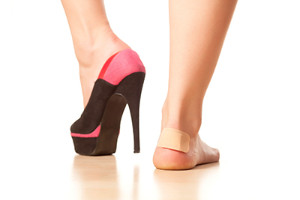 While high heels are not the most comfortable shoes to wear, the desire to have the foot look flattering may be ideal in certain situations. The price to pay for this admired look may be the formation of blisters and pain that often form while wearing this type of shoe. An additional downfall of wearing high heels, may be a stress fracture or a serious ankle injury, and this may also affect the Achilles tendon. Research has shown that foot pain generally occurs after spending an hour in high heels. This is typically a result of the weight being distributed to the balls of the feet and may often extend to the toes. If high heels are chosen to be worn frequently and for a considerable amount of time, the Achilles tendon may become stiff, and this may result in difficulty with walking. Relief may be found by practicing proper stretching exercises, preferably several times per day. If you choose to wear high heels, a consultation with a podiatrist is advised to learn about how to stretch your feet.
While high heels are not the most comfortable shoes to wear, the desire to have the foot look flattering may be ideal in certain situations. The price to pay for this admired look may be the formation of blisters and pain that often form while wearing this type of shoe. An additional downfall of wearing high heels, may be a stress fracture or a serious ankle injury, and this may also affect the Achilles tendon. Research has shown that foot pain generally occurs after spending an hour in high heels. This is typically a result of the weight being distributed to the balls of the feet and may often extend to the toes. If high heels are chosen to be worn frequently and for a considerable amount of time, the Achilles tendon may become stiff, and this may result in difficulty with walking. Relief may be found by practicing proper stretching exercises, preferably several times per day. If you choose to wear high heels, a consultation with a podiatrist is advised to learn about how to stretch your feet.
High heels have a history of causing foot and ankle problems. If you have any concerns about your feet or ankles, contact one of our podiatrists from Family Foot Care of Long Island. Our doctors can provide the care you need to keep you pain-free and on your feet.
Effects of High Heels on the Feet
High heels are popular shoes among women because of their many styles and societal appeal. Despite this, high heels can still cause many health problems if worn too frequently.
Which Parts of My Body Will Be Affected by High Heels?
- Ankle Joints
- Achilles Tendon – May shorten and stiffen with prolonged wear
- Balls of the Feet
- Knees – Heels cause the knees to bend constantly, creating stress on them
- Back – They decrease the spine’s ability to absorb shock, which may lead to back pain. The vertebrae of the lower back may compress.
What Kinds of Foot Problems Can Develop from Wearing High Heels?
- Corns
- Calluses
- Hammertoe
- Bunions
- Morton’s Neuroma
- Plantar Fasciitis
How Can I Still Wear High Heels and Maintain Foot Health?
If you want to wear high heeled shoes, make sure that you are not wearing them every day, as this will help prevent long term physical problems. Try wearing thicker heels as opposed to stilettos to distribute weight more evenly across the feet. Always make sure you are wearing the proper shoes for the right occasion, such as sneakers for exercising. If you walk to work, try carrying your heels with you and changing into them once you arrive at work. Adding inserts to your heels can help cushion your feet and absorb shock. Full foot inserts or metatarsal pads are available.
If you have any questions please feel free to contact our office located in Port Jefferson Station, NY . We offer the newest diagnostic and treatment technologies for all your foot and ankle needs.
Effect of High Heels on the Feet
For hundreds of years, women have been wearing various kinds of high heels for aesthetic reasons. Women who wear high heels appear to be taller and have longer and thinner legs, and the wearer’s gait and posture changes. Though high heels have had an association with femininity and have kept them popular over the years, there are definite health problems caused by wearing them too frequently.
The motion of the ankle joints is limited when heels are worn. The ankle joint is very important to the body when it comes to walking. Because of their location, these joints have a great deal of weight put on them. Thus, it is very important to keep them as healthy as possible. The Achilles tendon is the main tendon in the ankle. Wearing high heels too often, studies have shown, can cause the calf muscle and Achilles tendon to shorten and stiffen. This can cause problems when shoes without heels are worn.
By putting a great deal of pressure on the ball of the foot and by forcing the toes into a small toe box, high heels can cause or may worsen many foot problems. These include corns, hammertoe, bunions, Morton’s neuroma and plantar fasciitis.
Not only does wearing high heels regularly have negative effects on the feet, the rest of the body can suffer as well. The knees, one of the most important joints in the entire body, can be affected by wearing high heels. High heels can cause the knees to stay bent all the time. Also, it can cause them to bend slightly inward as well. Doctors believe that women can suffer from osteoarthritis later in life because of constantly walking like in high heels. By limiting the natural motion of the foot during walking, high heels also cause an increased in stress on the knees.
Similarly, high heels can cause the back to go out of alignment. If high heels are worn constantly, the spine’s ability to absorb shock can cause continued back pain. They can compress the vertebrae of the lower back, and can overuse the back muscles.
However, this is not to say that high heels can never be worn. If worn occasionally and not often, they will not cause serious problems. They should not be worn every day. It’s important to wear them modestly to avoid the long-term physical health problems of the feet, knees, ankles, and back mentioned above.
Symptoms of Toenail Fungus
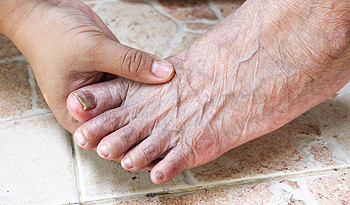 The big toe is generally the first toe to be affected by toenail fungus. It’s considered to be a common foot ailment, and will typically affect half the population by the time people reach 70 years old. There are several symptoms that are indicative of this condition, including the nail appearing unusually thick and possibly yellow or white. This ailment may cause the nail to separate from the nail bed which is referred to as onycholysis. If the infection is mild, it may help to treat the area by thoroughly washing and filing the affected nail followed by utilizing a mentholated rubbing cream. For more severe infections, it’s suggested to consult with a podiatrist who can advise on how to properly treat toenail fungus. This advice may typically include information about oral or topical antifungal medications.
The big toe is generally the first toe to be affected by toenail fungus. It’s considered to be a common foot ailment, and will typically affect half the population by the time people reach 70 years old. There are several symptoms that are indicative of this condition, including the nail appearing unusually thick and possibly yellow or white. This ailment may cause the nail to separate from the nail bed which is referred to as onycholysis. If the infection is mild, it may help to treat the area by thoroughly washing and filing the affected nail followed by utilizing a mentholated rubbing cream. For more severe infections, it’s suggested to consult with a podiatrist who can advise on how to properly treat toenail fungus. This advice may typically include information about oral or topical antifungal medications.
If left untreated, toenail fungus may spread to other toenails, skin, or even fingernails. If you suspect you have toenail fungus it is important to seek treatment right away. For more information about treatment, contact one of our podiatrists of Family Foot Care of Long Island. Our doctors can provide the care you need to keep you pain-free and on your feet.
Symptoms
- Warped or oddly shaped nails
- Yellowish nails
- Loose/separated nail
- Buildup of bits and pieces of nail fragments under the nail
- Brittle, broken, thickened nail
Treatment
If self-care strategies and over-the-counter medications does not help your fungus, your podiatrist may give you a prescription drug instead. Even if you find relief from your toenail fungus symptoms, you may experience a repeat infection in the future.
Prevention
In order to prevent getting toenail fungus in the future, you should always make sure to wash your feet with soap and water. After washing, it is important to dry your feet thoroughly especially in between the toes. When trimming your toenails, be sure to trim straight across instead of in a rounded shape. It is crucial not to cover up discolored nails with nail polish because that will prevent your nail from being able to “breathe”.
In some cases, surgical procedure may be needed to remove the toenail fungus. Consult with your podiatrist about the best treatment options for your case of toenail fungus.
If you have any questions, please feel free to contact our office located in Port Jefferson Station, NY . We offer the newest diagnostic and treatment technologies for all your foot care needs.
Toenail Fungus
Toenail fungus is a frustrating problem that affects many people. It can be persistent and hard to get rid of. As many different types of fungi are present throughout the environment, it is very easy to contract toenail fungus.
The feet are especially susceptible to toenail fungus because shoes and socks create the ideal dark and moist environment that fungal infections thrive in. While fungal infections of the nail plate are quite common, if left untreated they can spread beyond the toenail and into the skin and other parts of the body.
Signs of toenail fungus include a thickened nail that has become yellow or brown in color, a foul smell, and debris beneath the nail. The toe may become painful due to the pressure of a thicker nail or the buildup of debris.
Treatment for toenail fungus is most effective during the early stages of an infection. If there is an accumulation of debris beneath the nail plate, an ingrown nail or a more serious infection can occur. While each treatment varies between patients, your podiatrist may prescribe you oral medications, topical liquids and creams, or laser therapy. To determine the best treatment process for you, be sure to visit your podiatrist at the first signs of toenail fungus.
How to Avoid Cracked Heels
 Cracks in the skin of the heel of the foot, which are often referred to as fissures, can be painful and uncomfortable. If this condition is not treated promptly, serious infections may occur. This ailment is the result of insufficient moisture in the skin, and research has shown there may be several reasons for this to occur. Cold weather may often be a contributing factor, in addition to drinking insufficient amounts of water, poor nutrition, or not moisturizing the feet. This ailment may be more prevalent in diabetic patients or in people who stand for the majority of the day. Wearing proper footwear may prevent cracked heels from developing, and this may include choosing shoes that have a closed heel. Soaking the feet in a warm bath, followed by utilizing a good moisturizer, will not only benefit the feet but also feel good. If you are afflicted with severe fissures, please consult with a podiatrist for proper treatment options.
Cracks in the skin of the heel of the foot, which are often referred to as fissures, can be painful and uncomfortable. If this condition is not treated promptly, serious infections may occur. This ailment is the result of insufficient moisture in the skin, and research has shown there may be several reasons for this to occur. Cold weather may often be a contributing factor, in addition to drinking insufficient amounts of water, poor nutrition, or not moisturizing the feet. This ailment may be more prevalent in diabetic patients or in people who stand for the majority of the day. Wearing proper footwear may prevent cracked heels from developing, and this may include choosing shoes that have a closed heel. Soaking the feet in a warm bath, followed by utilizing a good moisturizer, will not only benefit the feet but also feel good. If you are afflicted with severe fissures, please consult with a podiatrist for proper treatment options.
If the skin on your feet starts to crack, you may want to see a podiatrist to find treatment. If you have any concerns, contact one of our podiatrists from Family Foot Care of Long Island. Our doctors can provide the care you need to keep you pain-free and on your feet.
Cracked Heels
It is important to moisturize your cracked heels in order to prevent pain, bleeding, and infection. The reason cracked heels form is because the skin on the foot is too dry to support the immense pressure placed on them. When the foot expands, the dry skin on the foot begins to split.
Ways to Help Heal Them
- Invest in a good foot cream
- Try Using Petroleum Jelly
- Ease up on Soaps
- Drink Plenty of Water
Ways to Prevent Cracked Heels
- Moisturize After Showering
- Skip a Shower
- Keep Shower Water Lukewarm
- Don’t Scrub Your Feet
If you are unsure how to proceed in treating cracked heels, seek guidance from a podiatrist. Your doctor will help you with any questions or information you may need.
If you have any questions, please feel free to contact our office located in Port Jefferson Station, NY . We offer the newest diagnostic and treatment technologies for all your foot care needs.
Solutions for Cracked Heels
Cracked heels can make life very frustrating and embarrassing when displaying the bare feet. Aside from being unpleasing to the eye, they can also tear stockings and socks and wear out shoes at a faster rate. When severe, cracked heels may cause pain or infection.
Cracked heels are a problem for those who are athletic, those who may walk a lot, and those who have especially dry skin. Those who use medication that dry the skin, those who swim often, wearing certain types of shoes, and those who are diabetic may have trouble with cracked heels. Seniors whose skin produces less oil may also have trouble with cracked feet. There is no one way to develop cracked feet, and there is no cure.
Today, the market consists of numerous products that have a variety of ingredients to promote healing. Some of these are over-the-counter. Others are prescribed by a doctor, especially for those who have chronic dry feet and heels.
Some doctors recommend wearing socks at night for those with rough skin. This helps further healing, and helps creams stay on longer and better absorb into the skin.
One way to alleviate dryness that causes cracked heels is by using moisturizers both day and night. Another way is to make sure the skin is clean and dry at all times. Using a pumice stone to buff away dead skin before putting on moisturizer can also help. Cracked heels will not respond to the cream unless the outer layer of skin is first removed through exfoliation. After exfoliation, lotion or ointment will be absorbed by the skin more easily.
Foods that produce healing and balance can also help the skin from within. Everything that is put into the body can either help it or hurt it. Taking supplements of omega-3 fatty acids and zinc can also be very beneficial.
Nevertheless, not all products are guaranteed to help treat cracked feet. Seeing a professional is best if other treatments options were unsuccessful. A podiatrist should be able to give the best advice to help with this problem.
Blog Archives
- April 2025
- March 2025
- February 2025
- January 2025
- December 2024
- November 2024
- October 2024
- September 2024
- August 2024
- July 2024
- June 2024
- May 2024
- April 2024
- March 2024
- February 2024
- January 2024
- December 2023
- November 2023
- October 2023
- September 2023
- August 2023
- July 2023
- June 2023
- May 2023
- April 2023
- March 2023
- February 2023
- January 2023
- December 2022
- November 2022
- October 2022
- September 2022
- August 2022
- July 2022
- June 2022
- May 2022
- April 2022
- March 2022
- February 2022
- January 2022
- December 2021
- November 2021
- October 2021
- September 2021
- August 2021
- July 2021
- June 2021
- May 2021
- April 2021
- March 2021
- February 2021
- January 2021
- December 2020
- November 2020
- October 2020
- September 2020
- August 2020
- July 2020
- June 2020
- May 2020
- April 2020
- March 2020
- February 2020
- January 2020
- December 2019
- November 2019
- October 2019
- September 2019
- August 2019
- July 2019
- June 2019
- May 2019
- April 2019
- March 2019
- February 2019
- January 2019
- December 2018
- November 2018
- October 2018
- September 2018
- August 2018
- July 2018
- June 2018
- May 2018
- April 2018
- March 2018
- February 2018
- January 2018
- December 2017
- November 2017
- October 2017
- September 2017
